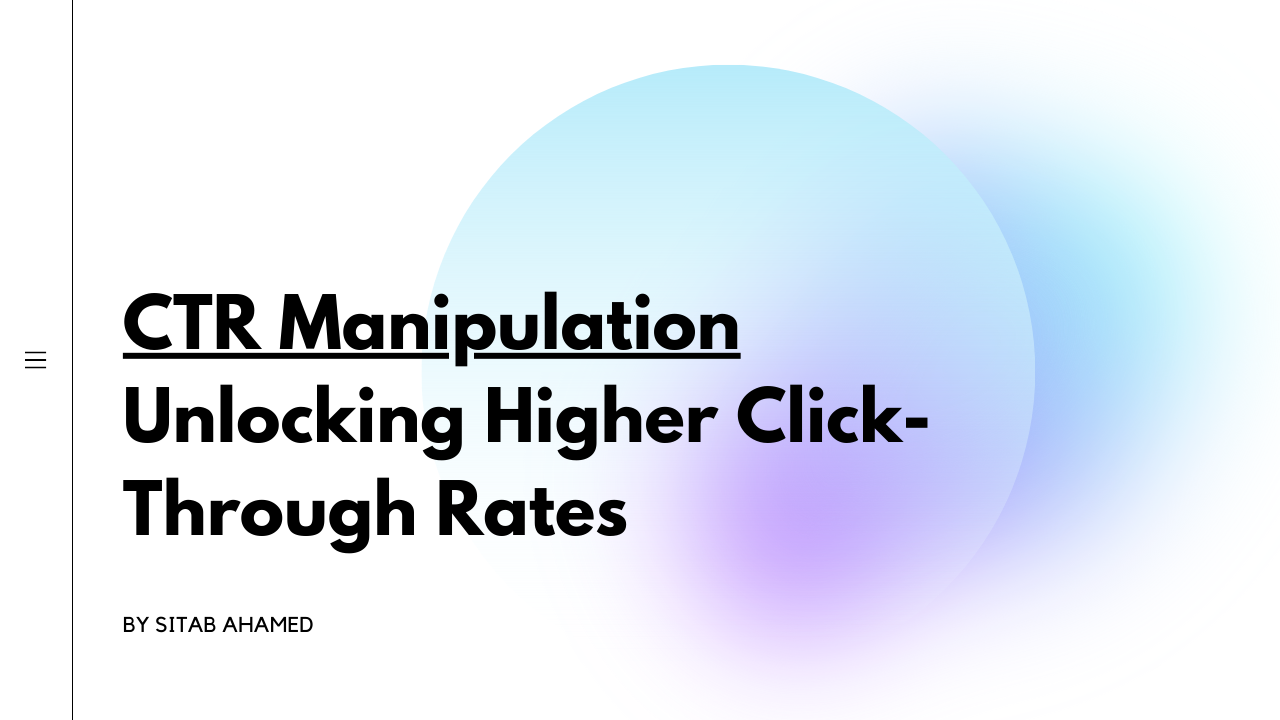CTR Adjustment: A Video Game Changer for Digital Projects
The rise of CTR manipulation has undoubtedly changed digital advertising approaches, offering marketing professionals with tools to enhance engagement and drive traffic properly. Techniques such as A/B testing and customized content have actually proven to generate substantial improvements in click-through rates. Nonetheless, as brands increasingly utilize these methods, the ethical implications of such practices necessitate examination. Stabilizing the search of optimized metrics with the need for genuine audience connections positions a crucial difficulty for marketers today. What effects might this balancing act hold for the future of electronic campaigns?
Understanding CTR Adjustment
Although click-through rate (CTR) control might seem like an uncomplicated strategy in digital marketing, it includes a series of techniques targeted at artificially inflating engagement metrics. This adjustment can take numerous kinds, including the use of click farms, robots, or deceitful advertisement positionings that deceive consumers into clicking. These approaches can jeopardize the honesty of efficiency data, making it challenging for marketing professionals to gauge the authentic performance of their projects.
Moreover, CTR control elevates moral worries, as it weakens the openness of digital marketing. The reliance on filled with air metrics can result in misdirected marketing choices, skewing source allocation and project strategies. Businesses might invest greatly in networks and techniques that show up successful however do not yield real engagement or conversions.

Advantages of Click-Through Rate Optimization
Optimizing click-through rate (CTR) is vital for enhancing the performance of digital advertising campaigns. A greater CTR indicates that a bigger proportion of customers are involving with the content, which can result in increased internet site traffic and far better conversion prices. By improving CTR, brand names can successfully assign their marketing sources to campaigns that generate the greatest returns.
One of the primary benefits of CTR optimization is the possibility for boosted advertisement placement and reduced prices - CTR Manipulation. Platforms like Google Ads compensate higher CTRs with much better advertisement positioning and reduced cost-per-click (CPC), allowing online marketers to stretch their spending plans further. Furthermore, a well-optimized CTR can boost brand presence, as higher engagement prices frequently associate with boosted natural reach

Strategies for Effective CTR Adjustment
To effectively adjust click-through rates (CTR), marketers can utilize a selection of tactical strategies that improve individual engagement and drive web traffic. One essential strategy is enhancing ad copy to develop engaging and action-oriented language. CTR Manipulation. Using strong call-to-action (CTA) phrases encourages individuals to take immediate action, raising the chance of clicks
An additional effective method is A/B testing, which permits marketers to contrast various ad variations. By systematically evaluating performance metrics, they can determine which aspects resonate best with the target market, thereby refining their techniques for maximum effect. Additionally, leveraging aesthetically attractive graphics and concise messaging can capture attention quickly, making it more likely that individuals will certainly involve.

Lastly, optimizing touchdown web pages to make certain a smooth individual experience can minimize bounce rates and encourage further interaction, inevitably cultivating greater CTR. By integrating these techniques, online marketers can efficiently manipulate CTR to achieve their project goals.
Determining Success in Digital Campaigns
Gauging success in electronic campaigns requires a clear understanding of key efficiency signs (KPIs) that align with project purposes. KPIs function as quantifiable metrics that aid analyze the performance of different strategies employed throughout the project. Typical KPIs include click-through prices (CTR), conversion prices, price per purchase (CPA), and return on investment (ROI)
To properly gauge success, it is crucial to develop certain, measurable objectives at the beginning of the project. If the primary purpose is to boost brand name awareness, metrics such as impacts and interaction prices may be focused on. On the other hand, campaigns concentrated on direct sales would certainly take advantage of a much more in-depth analysis of conversion rates and earnings produced.
Regular evaluation of these KPIs enables marketing experts to More hints make data-driven decisions, enhancing their approaches in real-time. Utilizing logical devices can aid in tracking performance and determining patterns, enabling swift adjustments to boost project outcomes. Eventually, a comprehensive strategy to gauging success not only highlights areas for improvement but additionally reinforces the total performance of electronic advertising and marketing efforts, driving sustained development and involvement in the long-term.
Future Patterns in Digital Advertising And Marketing
Anticipating the future of digital advertising exposes a landscape formed by quick technical innovations and altering consumer habits. As expert system and artificial intelligence remain to develop, marketers will significantly utilize these modern technologies to individualize projects at an extraordinary range. Anticipating analytics will certainly make it possible for brands to anticipate customer needs, optimizing ad positionings and material shipment in genuine time.
Moreover, the rise of voice search and smart tools is changing exactly how consumers communicate with digital content. Marketers will certainly require to adapt their strategies to ensure presence throughout several platforms, consisting of voice-activated assistants. This change demands an emphasis on conversational advertising, emphasizing involvement with dialogue instead than standard marketing strategies.
Furthermore, personal privacy issues are triggering adjustments in information collection techniques. Openness and ethical information usage will end up being extremely important, driving brands to promote count on and commitment among customers. The continuous evolution of social networks systems will additionally influence advertising and marketing methods, with a heightened focus on authenticity and user-generated material.
Verdict
In summary, CTR adjustment stands for a considerable development in digital advertising and marketing methods, providing immediate advantages with improved engagement metrics. The recurring development of electronic advertising and marketing will depend on this fragile interplay, forming the future landscape of brand-consumer communications.